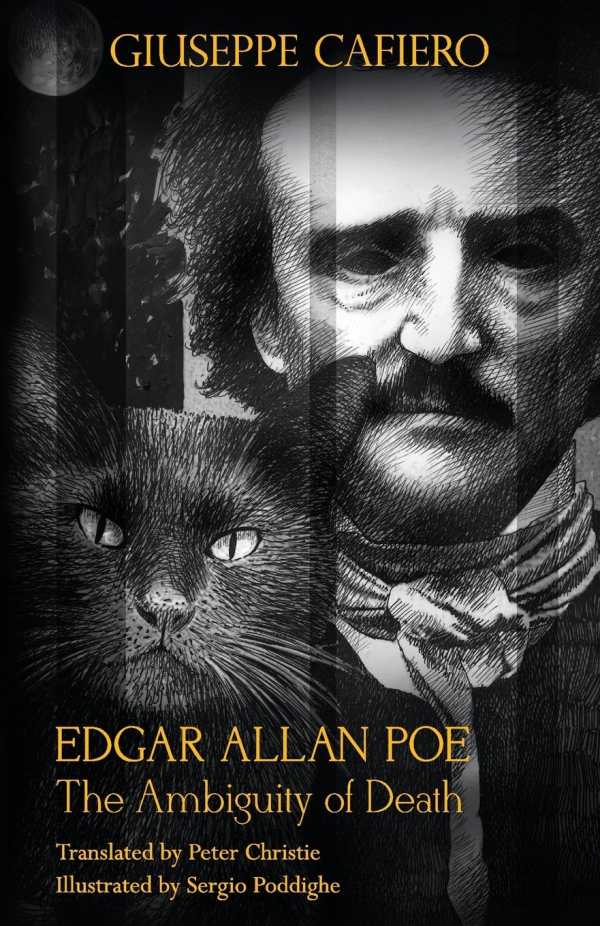It looks like you've stumbled upon a page meant to be read by our code instead of viewed directly. You're probably looking for this page.
Edgar Allan Poe
The Ambiguity of Death
Cafiero’s biofiction is an outstanding literary achievement. It deserves to be read.
Edgar Allan Poe: The Ambiguity of Death, the latest biographical novel by Italian author Giuseppe Cafiero, is a linguistically intricate and intensely cerebral examination of the life and writings of one of America’s most innovative, exceptional, and enigmatic writers.
It is October 8, 1849, the day after Edgar Allan Poe’s mysterious death. Contemptible rumors about Poe’s tragic life abound. The novel’s unnamed narrator is the editor of the Courier and Daily Compilerin Richmond, Virginia. He summons Dr. Joseph E. Snodgrass, an acquaintance of Poe who was one of the last to see him alive, and the Rev. Rufus W. Griswold, Poe’s literary rival who penned a pseudonymous defamatory obituary of him, to a tavern in Richmond to query them about their remembrances. The editor aspires to write an account of Poe’s life, yet when the stories devolve into drunken chatter, he examines Poe’s writings to decipher the “sordid ambiguities” of this much maligned literary genius.
Thus, guided by Mammy, Poe’s African American “mother-nanny,” the editor embarks on an Odyssean journey to interview the protagonists in many of Poe’s best-known stories and poems, and the intellectuals who have interpreted his works. The editor’s extensive trek is a veritable retracing of Poe’s footsteps, and Cafiero’s language captures the gloom, poverty, physical discomfort, and hardscrabble existence of nineteenth-century America.
Cafiero’s prose also reflects Poe’s own lengthy, layered, and rich sentence structure and Gothic style—a grand achievement given the novel is translated from Italian. With character descriptions such as “I was … a wretched apostle of misdeeds,” the author matches Poe’s artfulness.
Although the styles are complementary, Cafiero favors a boisterous, repetitive, and interrogatory method. For instance, syntax such as “partial confidences and confidential partialities” and “insane slander and slanderous insanity” are clever, but lack specificity. There’s a liveliness to Cafiero’s writing that pushes momentum, making it seem as if words cannot be composed fast enough on the page. Meanwhile, Poe opted for the slow-building emphasis on drama, suspense, and reasoning—the inestimable artistry that credits him as the originator of the detective story and the stylist who imbued his work with dark, disquieting psychological portrayals of obsession, madness, grief, and isolation.
Assuredly, there’s no dearth of psychology in Cafiero’s Poe. As a fictionalized biography—or “bio-fiction,” as the author terms his works, which include Vincent van Gogh: The Ambiguity of Insanity—the novel speculates about Poe’s character, motivations, influences, habits, emotions, and mindset as they inform Poe’s anthology of the macabre.
And in his vision of Poe, Cafiero interprets his works as strict autobiography. Poe’s tales are born “amid the horrible representations and vile horrors of an excessively hallucinatory mind” addled by alcohol, opium, and the intolerable deaths of the women in his life—his mother, Elizabeth; foster mother, Frances; and wife, Virginia. Unfortunately, most characters—many of whom are mired in their own madness—reinforce this one-dimensional view.
Such reductionism is Poe‘s greatest flaw. Yet, Cafiero’s biofiction is an outstanding literary achievement. It deserves to be read.
Reviewed by
Amy O'Loughlin
Disclosure: This article is not an endorsement, but a review. The publisher of this book provided free copies of the book and paid a small fee to have their book reviewed by a professional reviewer. Foreword Reviews and Clarion Reviews make no guarantee that the publisher will receive a positive review. Foreword Magazine, Inc. is disclosing this in accordance with the Federal Trade Commission’s 16 CFR, Part 255.
